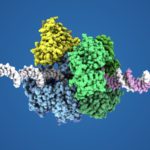Lien vers Pubmed [PMID] – 31103775
Lien DOI – S0022-2836(19)30286-410.1016/j.jmb.2019.05.017
J Mol Biol 2019 09; 431(20): 4167-4183
DNA and RNA polymerases (DNAP and RNAP) play central roles in genome replication, maintenance and repair, as well as in the expression of genes through their transcription. Multisubunit RNAPs carry out transcription and are represented, without exception, in all cellular life forms as well as in nucleo-cytoplasmic DNA viruses. Since their discovery, multisubunit RNAPs have been the focus of intense structural and functional studies revealing that they all share a well-conserved active-site region called the two-barrel catalytic core. The two-barrel core hosts the polymerase active site, which is located at the interface between two double-psi β-barrel domains that contribute distinct amino acid residues to the active site in an asymmetrical fashion. Recently, sequencing and structural studies have added a surprising variety of DNA and RNA to the two-barrel superfamily, including the archaeal replicative DNAP (PolD), which extends the family to DNA-dependent DNAPs involved in replication. While all these polymerases share a minimal core that must have been present in their common ancestor, the two-barrel polymerase superfamily now encompasses a remarkable diversity of enzymes, including DNA-dependent RNAPs, RNA-dependent RNAPs, and DNA-dependent DNAPs, which participate in critical biological processes such as DNA transcription, DNA replication, and gene silencing. The present review will discuss both common features and differences among the extended two-barrel polymerase superfamily, focusing on the newly discovered members. Comparing their structures provides insights into the molecular mechanisms evolved by the contemporary two-barrel polymerases to accomplish their different biological functions.

